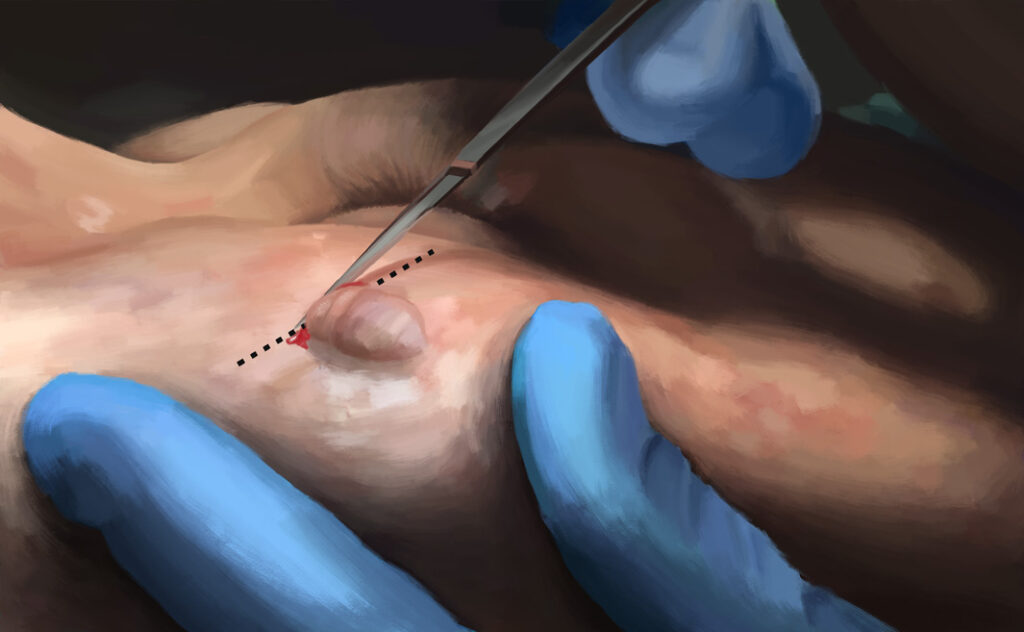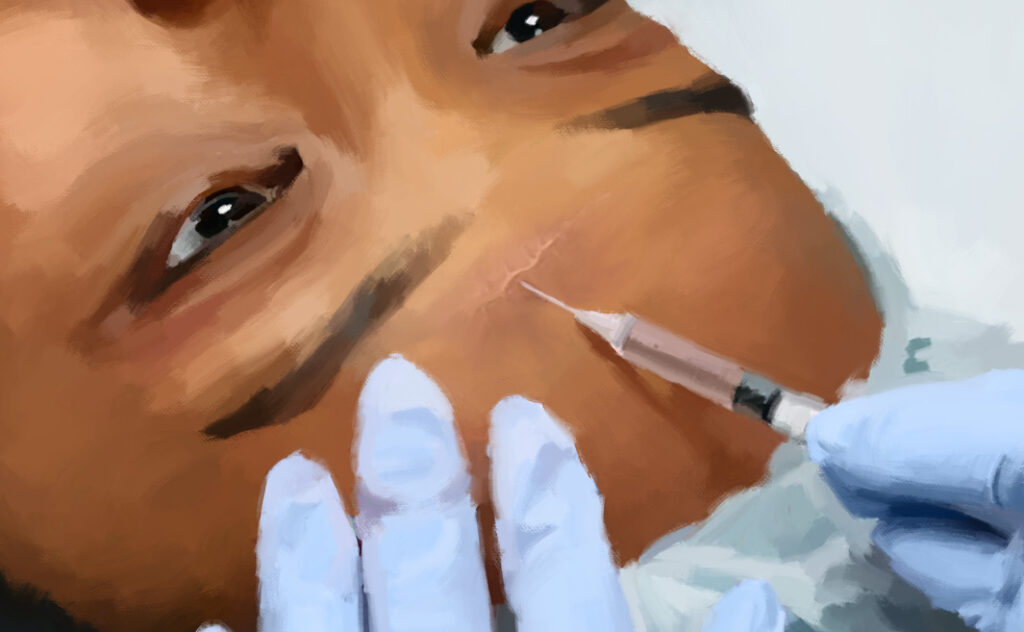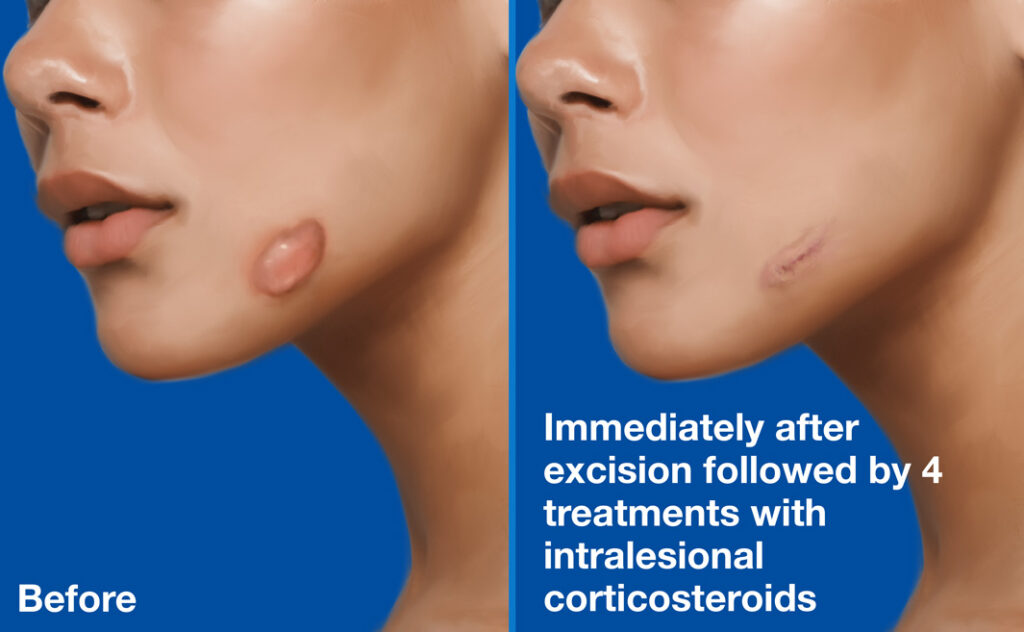Raised scars contain excessive collagen, or in other words, scars caused by an overgrowth of collagen.
Excision with corticosteroids is a two-pronged approach to treating raised scars. The treatment consists of two steps:
- Excision (cutting out the scar): In excision, the scar is surgically removed under local anesthesia. The doctor uses a scalpel to remove one scar at a time, leaving behind a smaller, linear scar. The edges of the wound are sutured (sewn together) after the procedure. 1,2
- Corticosteroids (intralesional): Keloid scars are likely to regrow if treated with excision alone. Therefore, doctors follow excision up with injecting corticosteroids directly into the tissue where the scar used to be within a few days to prevent keloid regrowth.2,3
Corticosteroids are synthetic (made in a laboratory) drugs that may help by:
- Decreasing collagen production
- Decreasing the number of fibroblasts (cells that produce collagen)4
Since excision is an invasive procedure, it is important to find a skilled doctor with extensive experience specifically in treating acne scars with this technique.
As with all scar revision treatments, the combination of excision with intralesional corticosteroids is sometimes combined with other scar revision procedures to achieve desired results.
Before agreeing to undergo excision with intralesional corticosteroid treatment, discuss your options, expected outcomes, and prices with multiple doctors.
Procedure details:
The first step is the surgical removal of the scar, which is called excision.
Excision begins with these steps:
- Marking the scar(s): The doctor uses a marker to indicate the scars to be removed.
- Cleaning the skin: The skin is cleaned with povidone-iodine, a broad-spectrum antiseptic.
- Numbing the skin: The doctor injects the skin with a local anesthetic. About 10-15 minutes later, the skin becomes sufficiently numb and the blood vessels in the skin decrease in diameter, ensuring minimal bleeding during the procedure.1-5
After preparing the skin, the doctor performs the excision:
- Cutting out the scar: A scalpel is used to cut the raised scar out
- Sewing up the wound: The edges of the wound are then sutured (sewn together)2

An injection of corticosteroid is next:
The standardized protocol involves the injection of corticosteroids directly under the scar immediately after the procedure and then scheduled injections every 2 weeks after excision for a total of 5 injections.4 However, in some cases, your doctor may inject a corticosteroid as soon as 7 days after the excision and adjust the number of corticosteroid treatments according to your needs.3
While data is still insufficient to say for sure, it appears that receiving a corticosteroid injection immediately after excision may prevent recurrence much better than if you wait 7 days to receive an injection.
The most commonly used intralesional corticosteroid for keloid scar treatment is triamcinolone, although other corticosteroids are also now being used. The corticosteroid is injected into the middle of the dermis, the deeper skin layer underneath the raised scar.

Depending on the extent of the scarring, the doctor may adjust several factors in intralesional corticosteroid treatment:
- Number of treatment sessions: Larger scars sometimes require more injections than smaller scars, but in general, 5 injections are usually necessary.
- Corticosteroid dose: Typical doses of corticosteroids are 10-20 mg/ml, but can be as high as 40 mg/ml. Your doctor must weigh the efficacy of the treatment, which tends to increase with a higher dose, against the risk of side effects, which also increases with a higher dose.4
Anesthesia:
Excision requires anesthesia and your doctor will numb the skin with an injection of local anesthesia prior to the procedure1-5
Intralesional injection of corticosteroids can also be painful. Your doctor may choose to reduce the pain of an intralesional corticosteroid injection with:
- A topical numbing cream which is applied 30 to 60 minutes prior to the injection
- An injection of a local anesthetic mixed with the corticosteroid in the same syringe1-5
Before-and-after:

A raised scar before and after the excision followed by 4 intralesional corticosteroid injections.
References
- Jacobs C, Wilmink J. Combined versus single treatment regimens for keloid therapy using serial intralesional corticosteroid injections, surgical excision, silicone- and/or cryotherapy. JPRAS Open. 29, 157-66 (2021).
- Wang, Ru, et al. “Corticosteroid Injection Alone or Combined with Surgical Excision of Keloids versus Other Therapies Including Ionising Radiotherapy: A Systematic Review and Meta-Analysis of Randomised Controlled Trials.” European Burn Journal 2(2), 41-54 (2021).
- Chua, Seng Chai, Beata Gidaszewski, and Marjan Khajehei. “Efficacy of surgical excision and sub-dermal injection of triamcinolone acetonide for treatment of keloid scars after caesarean section: a single blind randomised controlled trial protocol.” Trials 20, 1-9 (2019).
- Hayashi, Toshihiko, et al. “A new uniform protocol of combined corticosteroid injections and ointment application reduces recurrence rates after surgical keloid/hypertrophic scar excision.” Dermatologic surgery 38(6), 893-97 (2012).
- Bijlard, Eveline, et al. “Intralesional cryotherapy versus excision with corticosteroid injections or brachytherapy for keloid treatment: Randomised controlled trials.” Journal of Plastic, Reconstructive & Aesthetic Surgery, 71(6), 847-56 (2018).
- Gupta, Atula, et al. “Evidence-based surgical management of post-acne scarring in skin of color.” Journal of Cutaneous and Aesthetic Surgery 13(2), 124 (2020).
 Acne.org Products
Acne.org Products